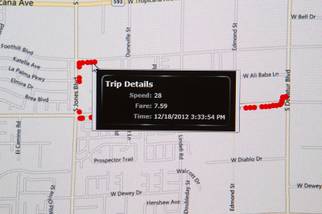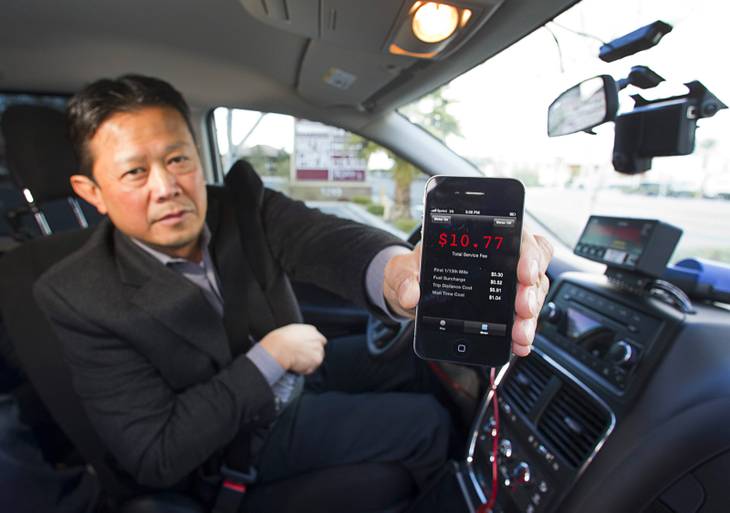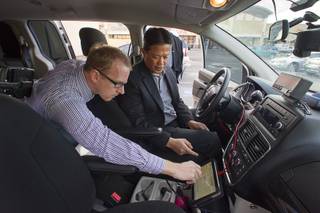RideIntegrity

Viewing video requires the latest version of Adobe's Flash Player
Frias Transportation Infrastructure shows Las Vegas Sun reporter Rick Velotta how their newest app RideIntegrity works. The new app is suppose to virtually eliminate all long hauling issues.
VEGAS INC Archives
- Authorities trying new ways to curb taxicab long-hauling (06-29-2012)
- Taxicab Authority checkpoints to crack down on long-hauling (06-06-2012)
- Trying to nab cabbies who long-haul fares isn’t easy (09-14-2011)
- Five steps to quickly fix Las Vegas’ taxi debacle (05-23-2011)
- How should taxi long-hauling be enforced? (05-16-2011)
- Long ride to Bellagio sparked taxicab long-haul battle (07-23-2010)
A Las Vegas company is testing a cloud-based vehicle monitoring system that could revolutionize transportation regulation and help solve one of the Nevada Taxicab Authority’s biggest problems: the illegal long-hauling of taxi passengers.
Frias Transportation Infrastructure, a technology company operated by the managers of the Frias Transportation Group — which runs the largest group of taxicab companies in Clark County — has spent three years developing RideIntegrity, a computer hardware and software system.
“We think that implementation of RideIntegrity would virtually eliminate the long-haul issue,” said Mark James, CEO of Frias Transportation Infrastructure, also known as FTi.
Long-hauling — when a cab driver takes a customer on an indirect route to a destination to generate a higher fare — has given a black eye to the city’s taxi industry for years, and regulators have been frustrated that they don’t have the manpower to police the problem.
The illegal practice commonly occurs when passengers are picked up at McCarran International Airport and transported through the runway tunnel to the Strip, increasing the fare by $5 to $20. Drivers are allowed to take the longer route to avoid traffic only if they first receive permission from the customer.
FTi’s system would enable regulators to monitor cab movement in real time, store data on routes from trips and play them back to investigate complaints involving allegations of long-hauling.
James has demonstrated the system to Taxicab Authority Administrator Charles Harvey and to Nevada Transportation Authority Chairman Andrew MacKay, who offered a letter of support for the project. FTi has asked the two regulatory boards to put a demonstration of the system on their January meeting agendas.
James also showed the system to attendees at the International Association of Transportation Regulators conference in November in Washington. He said regulators in San Francisco and New York are interested in it. Representatives of the National Conference on Weights and Measures and the National Institute of Standards and Technology also have seen a demonstration.
James said testing will continue, and the company expects to roll out a completed product by March.
FTi set its sights on RideIntegrity after seeing an opportunity to offer the first alternative to taxi metering in decades. Instead, they ended up developing a system that could be used as a regulatory enforcement tool.
Here’s how it works: Each cab is equipped with a GPS transponder that can be programmed to include the operating parameters of the vehicle. For example, in Las Vegas, cab companies are issued “medallions” that can restrict the geographic or time usage of a vehicle.
The transponder, plugged into a vehicle’s onboard diagnostic port, reports the speed and route of a cab much like a “black box” monitors the movement and speed of an airplane. At the end of each trip, the time, route and fare are logged by computer and stored in a database. The information can be retrieved later if there are questions about the transaction.
RideIntegrity also stores licensing, registration and drug testing information on drivers, and regulators can be flagged if someone who isn’t authorized attempts to drive a vehicle.
In a demonstration, Chief Technology Officer Leo Samson and members of his team drove a RideIntegrity-equipped vehicle on a four-mile trip in southwest Las Vegas, then called up the trip from the database at a monitoring station and displayed it on a computer screen. A dashboard in the test vehicle also showed the fare, just as a taxi meter displays it, and the route on a Google map.
James said his team is developing apps that would enable customers to monitor the route and determine if the driver is taking the most direct way. The system also could support an e-hailing option that would enable cab customers to hail the closest available cab with their smartphones.
James didn’t disclose the cost of the system but said the company has spent millions of dollars developing it. He envisions regulatory agencies paying for the system through software licensing fees and small transaction charges on vehicles. He said over time, the system could save hundreds of thousands of dollars in enforcement costs.
Harvey said he was impressed with what he saw but noted that it would likely take several months for a system to be installed.
“There’s no budget or project at this time, and this is all pretty new,” Harvey said. “Once they present it, if the board is interested in pursuing it, we would have to go through the state and demonstrate the need. I have no idea what costs are involved, and our current Taxicab Authority monitoring equipment is outdated.”
Harvey said it’s a lengthy process to get funds for a work program, but the Nevada Legislature meets in February and Harvey said he’ll meet with the Legislative Counsel Bureau next week.
“There’s a lot of due diligence that’s necessary, but what I’ve seen so far is pretty exciting,” he said.

